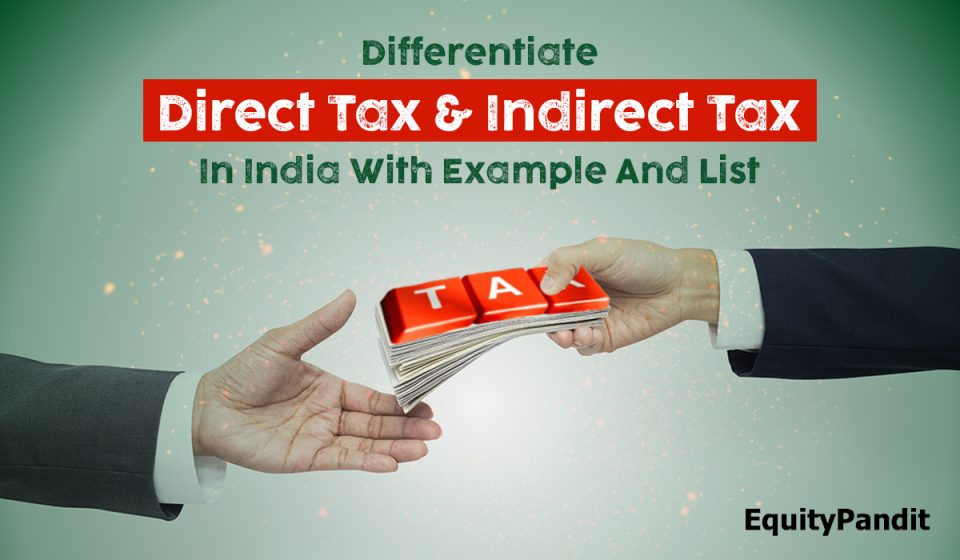Introduction
People residing in a country have to necessarily pay the taxes to the government of that country. Taxes come in different forms. Whether you are going to a restaurant, or purchasing from a shop, or taking a loan, on most of the transactions and on your income the taxes are levied in India.
Basically, tax is a type of fee levied by the government of an economy on an organisation or an individual, in order to collect revenue for public expenditures. In India, there are broadly two types of taxation: Indirect tax and Direct Tax.
In this blog, we have covered these two different forms of taxation and how they differentiate from each other. Further, we have covered different sub-types of these taxes with an example of each.
What Is Direct Tax?
The direct tax, as the name says is directly paid to the Government of India by an individual or an entity. Direct tax can’t be transferred to others. Direct tax is governed by the Central Board of Direct Taxes (CBDT). The Income Tax Act, 1961, along with the amendments in the act have to be followed in India.
Under the Income Tax Act, 1961, it’s compulsory to pay tax on the income generated by an individual or an entity. This happens when your annual income is above the minimum exemption limit as disclosed and amended from time to time of the Income Tax Act, 1961.
Income tax has to be paid in the assessment year, which is immediately next year to the financial year in which such income has been generated. Types of Direct taxes include Income tax, Corporate tax and Capital gains tax.
What is Indirect Tax?
Indirect taxes are imposed on goods and services, while direct taxes apply to the income and profits an individual or entity generates.
The indirect taxes are typically collected from the final consumer through an intermediary. The intermediary is then responsible for transferring the collected tax to the government.
The primary difference between direct and indirect taxes is in their collection methods and the role of the intermediary.
The indirect taxes are governed and administered by the Central Board of Indirect Taxes and Customs (CBIC).
Differences Between Direct tax and Indirect tax
| Particulars | Direct Tax | Indirect Tax |
| Shift of tax burden | The tax burden cannot be shifted, i.e., the person who pays the tax to the Government cannot recover it from somebody else. | The tax burden can be shifted, i.e. the person paying the tax passes on the incidence to another person. |
| Levy of taxation | Tax on income or wealth | Tax on goods or services |
| Nature of taxation | Progressive in nature. This means as the income increases, the tax rate also increases. A higher tax is collected from the ones earning high and vice versa | Indirect taxes like GST are proportional in nature. This is a mechanism where individuals and entities are levied uniform rate of taxes on goods and services, irrespective of their income. It is also called flat tax rate system. |
| Types | Income Tax, Corporate Tax, Capital Gain Tax | Goods and Services Tax, Custom Duty, etc. |
| Pros | Helps in controlling inflation and reduces inequalities in an economy | All categories of income payers will pay indirect tax. For example, tax is paid by even the poor on the goods or services purchased by the individual. |
| Cons | Tax evasion is possible while the direct taxes. Further, there’s a possibility that individuals or entities don’t go much investments with retain themselves back from paying capital gain tax, security transaction tax, etc. | Tax payers from different income categories are required to pay on the same rate of tax levied on different goods and services. Therefore, even for the products where indirect taxation rate is high, all category tax payers have to pay the taxes. This says that it’s not an equitable approach. |
List of Direct and Indirect Taxes In India
Direct taxes include India Income tax, Corporate tax, Securities Transaction tax, Capital Gains tax, Gift tax, Wealth tax, Property tax, Education cess, Entertainment Tax, Professional tax, etc.
Indirect taxes in India include Goods and Services tax, Customs Duty, Octroi Duty, Value Added Tax (VAT), etc.
Examples of Direct and Indirect Tax
Direct Tax Example:
The direct tax is levied on the income of an individual or entity. Below is an example which you can relate, and find the computation of direct tax in India for an Individual.
Computation of income tax from the salaried income of an individual
Here is the new income tax regime to be computed for the financial year 2024-25, for individuals below 60 years of age.
| Income limit (In Rs) | Tax Rate |
| 0-3,00,000 | Nil tax |
| 3,00,001-7,00,000 | 5% |
| 7,00,001-10,00,000 | 10% |
| 10,00,001-12,00,000 | 15% |
| 12,00,001-15,00,000 | 20% |
| Above 15,00,000 | 30% |
Suppose an individual has a salaried income of Rs 10,00,000 in the financial year (FY) 2023-24. Therefore, the assessment year (AY) for paying the tax generated on the salaried income will be AY 2024-25. Suppose, after doing the exemptions from the gross salary (such as house rent allowance, leave travel allowance, etc.), and taking deductions under section 80 C, and all other deductions, the taxable income is Rs 7,75,000.
The tax slab can be imposed on Rs 7,75,000, and comes to Rs 27,500. The calculation is done through the following steps-
- Subtract Rs 3,00,000 from Rs 7,75,000. This comes to Rs 4,75,000, as the tax rate on this is nil, no tax will be imposed on it.
- Now, going to the second slab of Rs 3,00,001-7,00,000, where the tax rate is 5%, subtract 3,00,000 from 7,00,000. It’s Rs 4,00,000. Therefore, on Rs 4,00,000, imposing a tax rate of 5%, we get Rs 20,000.
- Now, subtract Rs 4,00,000 from Rs 4,75,000. We get Rs 75,000.
- Then, on the remaining amount of Rs 75,000, the next tax slab (7,00,001 to 10,00,000) is imposed, which has a tax rate of 10%. Therefore 10% on Rs 75,000 comes as Rs 7,500.
- Combining the income tax from point ‘b’ and ‘d’, we get Rs 20,000 plus Rs 7,500, i.e. Rs 27,500 as the total income tax to be imposed for the AY 2024-25 for the individual with taxable salary income as Rs 7,75,000.
- Further, the individual has to the education and health cess as well of Rs 1,100. Therefore, this would be added to the total income tax computed. This comes to a total income tax Rs 28,600 (Rs 27,500 plus Rs 1,100), to be paid to the government in AY 2024-25.
Note: For income from house property, capital gains and other sources, there are different tax rates. You can calculate the income tax from these incomes by using an online income tax calculator.
Computation Of Corporate Tax For The Corporate
The domestic companies in India are taxed at a rate of 25% on the Net profit (Profit before tax) from the financial year (FY) 2024-25. Suppose, the income or the profit before tax (PBT) for a domestic company in India is Rs 20,00,000. Therefore, the income tax from the above taxable income is Rs 5,00,000 (25% of Rs 20,00,000).
Indirect Tax Example:
It includes Goods and Services Tax (GST), Customs duty, etc.
In India, for most of the goods and services, the GST rate is currently at 5%, 12%, 18%, and 28%.
GST
Suppose, a consultant sells its services at Rs 1,00,000. The GST rate for services in 18%. Therefore, the output tax liability is Rs 18,000 (1,00,000*0.18). Then, the consultant purchases some office goods worth Rs 50,000. The input tax is 5% GST on the purchase of goods. So, paying 5% of GST on Rs 50,000 is Rs 2,500.
Therefore, the tax payable by the consultant will be Rs 15,500 (Rs 18,000 minus Rs 2,500).
Customs duty
The Basic customs duty (BCD) ranges from 0% to 100% in India. It depends upon the Harmonised System (HS) Code and its origin.
Frequently Asked Questions (FAQs)
What is an assessment year?
An assessment year is the year immediately succeeding the financial year, in which the income is generated. The Income tax to be payable is in the assessment year, based on the income derived in the immediately preceding financial year.
What is the current corporate tax rate in India for domestic companies?
For domestic companies, the corporate tax to be imposed on Profit before tax (PBT) is 25%.
What is the current GST rate on services imposed in India?
The current GST rate on services in India is 18%.
Who governs the Indirect tax in India?
The Indirect taxation in India is governed by Central Board of Indirect Taxes and Customs (CBIC).
Which act governs the Direct taxation in India?
The Direct taxation in India is governed by the Income Tax Act, 1961.
What is Proportional tax?
Under the proportional tax mechanism, the taxing authority imposes the same rate of tax on each type of tax-payer, irrespective of their income.
Ready to invest like a pro? The Unicorn Signals app equips you with 100+ Free tools and knowledge you need to succeed. Download the Unicorn Signals app and gain access to daily stock lists, insightful market analysis and, much more!
 Live
Live

